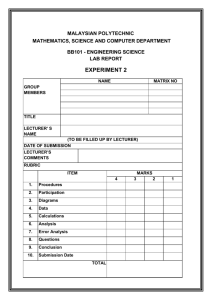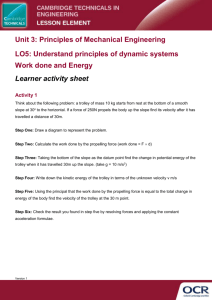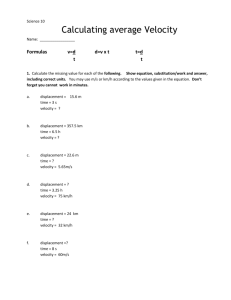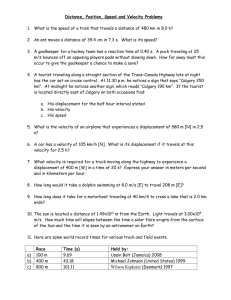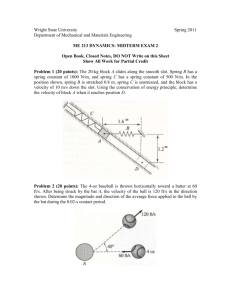Speed, Deiplacement and Velocity
advertisement
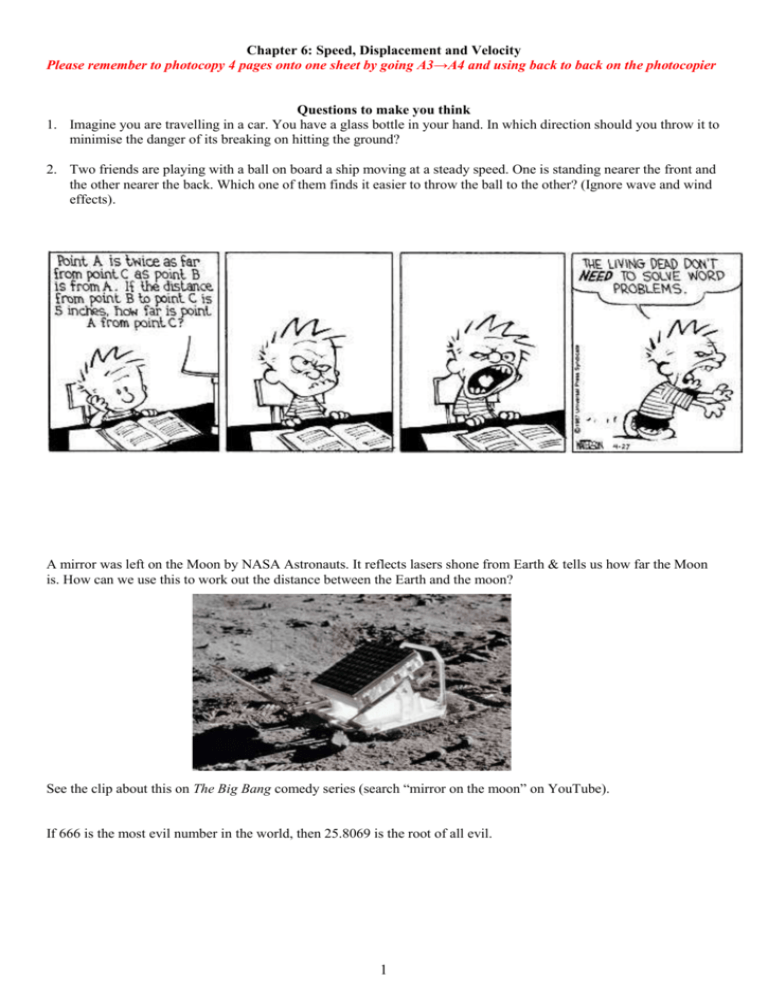
Chapter 6: Speed, Displacement and Velocity Please remember to photocopy 4 pages onto one sheet by going A3→A4 and using back to back on the photocopier Questions to make you think 1. Imagine you are travelling in a car. You have a glass bottle in your hand. In which direction should you throw it to minimise the danger of its breaking on hitting the ground? 2. Two friends are playing with a ball on board a ship moving at a steady speed. One is standing nearer the front and the other nearer the back. Which one of them finds it easier to throw the ball to the other? (Ignore wave and wind effects). A mirror was left on the Moon by NASA Astronauts. It reflects lasers shone from Earth & tells us how far the Moon is. How can we use this to work out the distance between the Earth and the moon? See the clip about this on The Big Bang comedy series (search “mirror on the moon” on YouTube). If 666 is the most evil number in the world, then 25.8069 is the root of all evil. 1 Student Notes The second is the unit of time. The metre is the unit of distance. Speed is the rate of change of distance with respect to time. The unit of speed is the metre per second (m s-1 or m/s) 𝑎𝑣𝑒𝑟𝑎𝑔𝑒 𝑠𝑝𝑒𝑒𝑑 = 𝑑𝑖𝑠𝑡𝑎𝑛𝑐𝑒 𝑡𝑖𝑚𝑒 Instantaneous Speed It is important that you understand the difference between average speed and instantaneous speed. When your speedometer indicates that you are doing 120 kph, it’s telling you that your instantaneous speed is 120 kph, not (obviously) your average speed for the journey. But to calculate instantaneous speed, you just take your average speed over a very short time. We come across this concept again in the next chapter. Displacement is distance in a given direction This can be a little tricky to grasp; it’s like saying that displacement is the straight-line distance between the two points. If you travel half-way around a circular race-track of radius 100 m, your distance travelled will be half the circumference of the circle (2πr/2) which is this case would be 100π m (or 314 m), but your displacement would be the straight line distance, in this case the diameter of the circle; 200 m. Velocity is the rate of change of displacement with respect to time The unit of velocity is the metre per second (ms-1, or m/s). 𝑣𝑒𝑙𝑜𝑐𝑖𝑡𝑦 = 𝑑𝑖𝑠𝑝𝑙𝑎𝑐𝑒𝑚𝑒𝑛𝑡 𝑡𝑖𝑚𝑒 So in the example above if you travel through one full circuit (finishing back where you started) in 10 seconds, your distance travelled will be 628 m, your displacement will be zero, your average speed will be 628/10 = 62.8 m s-1, but your average velocity will be zero (because the displacement is zero). WTF? Yes this does seem bizarre, but that’s how we roll here in the world of Physics, and it turns out that many of the Physics equations which we use in the next chapter refer to displacement, not distance (although if the distance travelled is in a straight line anyway, then distance travelled will be equivalent to displacement). Distance–Time Graphs (for an object travelling at constant velocity) If you plot a graph of Distance (on the y-axis) against Time (on the x-axis), the slope of the graph will be the speed of the object. slope = Mandatory Experiment Measuring Velocity using a Ticker –Tape-Timer 2 y 2 y1 x2 x1 Leaving Cert Physics Syllabus: Velocity Content Linear Motion Depth of Treatment Activities STS Units of length and time Definitions of units not required Displacement and velocity Definitions and units Measurement of velocity using any suitable apparatus Use of distance-time graph 3 Sports, e.g. athletics MEASUREMENT OF VELOCITY USING A TICKER-TAPE TIMER APPARATUS: Ticker timer and tape, low-voltage a.c. power supply, trolley, runway. DIAGRAM PROCEDURE 1. Set up the apparatus as in the diagram. 2. Connect the ticker timer to a low-voltage power supply. 3. Give the trolley a small push to start it moving. 4. Adjust the angle of inclination of the runway until the trolley moves with constant velocity, i.e. the spots on the tape are all equidistant. 5. The ticker timer makes 50 spots per second. Therefore the time interval between two adjacent spots is 0.02 s. 6. Measure the length s of ten adjacent spaces. 7. The time t is 10 × 0.02 = 0.2 s. 8. As the trolley was travelling at constant velocity we can say that velocity = distant/time 9. Repeat using pushes of varying strengths. 10. Tabulate results as shown. RESULTS s (m) t (s) v (m s-1) CONCLUSION The dots were evenly spaced throughout, illustrating that the velocity remained constant. SOURCES OF ERROR / PRECAUTIONS 1. Dust the runway to reduce friction. 2. Raise the trolley to offset friction such that the trolley moves at constant velocity. 3. Ignore the initial five or six dots on the tape as this shows the initial acceleration due to the push. QUESTIONS 1. For ten spaces we need eleven dots. What would be the effect (if any) of using five spaces instead of ten? 2. What would be the effect of using twenty spaces? 3. What would be the effect of giving the trolley a high initial velocity? NOTES 1. Ensure that the voltage rating of the timer is not exceeded. 2. Ignore the initial five or six dots on the tape as this shows the initial acceleration due to the push. 3. If the paper is turned the wrong way around it will be hard to spot any pattern. Exam Question [2003] A cyclist travels from A to B along the arc of a circle of radius 25 m as shown. (i) Calculate the distance travelled by the cyclist. (ii) Calculate the displacement undergone by the cyclist. Solution (i) The displacement is equivalent to one quarter of the circumference of a circle = 2πr/4 = 25π/2 = 12.5π = 39.3 m. (ii) Using Pythagoras: x2 = 252 + 252 x = 35.3 m. Direction is NW 4

